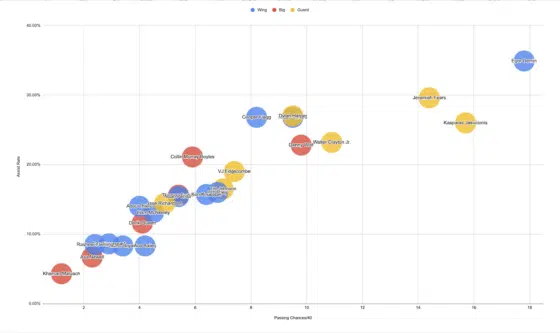No part of basketball captivates me like beautiful passing does. Possibly reflective of my basketball strengths and weaknesses, I’ve always felt partial to brilliant players with a sixth sense for playmaking. Hours of watching Jason Williams, Steve Nash and Chris Paul passing highlights growing up led me to my most ambitious scouting project to date.
Passing is a critical component of basketball scouting, yet there’s a lack of depth in traditional evaluation of playmaking. Basic passing analysis starts and ends with assist and turnover counts. Even more ‘advanced’ passing stats like assist-to-turnover ratio, assist rate and passing-by-playtype link back to the box score.
Problems surrounding passing evaluation center around one idea — not all assists (and turnovers) are equal, though the box score views them as such. Though raw assist totals point in the direction of the best passers in a given class, there’s so much more to passing than the outcome of the possession.
Take this assist from Cooper Flagg — screening action between Kon Knueppel and Sion James springs James wide open downhill. Flagg simply has to pass the ball forward to a wide-open target who finishes the play:
Flagg manufactured assist pic.twitter.com/w3GaGR7MWy
— bjpfclips (@bjpfclips) June 23, 2025
Compare the play above, which added one assist to Flagg’s total, to this play, which is my personal favorite pass of the 2025 cycle. Flagg drives baseline, twists in midair under heavy pressure and kicks it out for a wide-open three and an assist in the box score:
cooper flagg insane twisting passing under pressure pic.twitter.com/cPvMoccS2J
— bjpfclips (@bjpfclips) February 19, 2025
The first clip presented a fairly basic pass. Flagg had to read the action unfolding and pass over a defender, but most NBA-caliber players comfortably convert that pass. The second clip, worth the same box score value as the first, demonstrates high-level vision, creativity and spatial awareness from Flagg, as well as an ability to pass under pressure.
This basic example underscores the need for more detailed analysis when projecting plamymaking. In pursuit of a deeper understanding of the passers in this draft, I set out to watch an ungodly amount of passes, hand-tracking different passing features to better describe true passing talent.
Football stats inspired this project, as I always envied the depth and diversity of metrics and insights about the game described quantitatively. I mirrored some of what Pro Football Focus attempts to achieve with their passing metrics, subjectively evaluating a quarterback’s ball placement, anticipation, arm strength and pocket presence, all important football traits that basic stats struggle to capture.
It would be impossible for one person to watch every second of every prospect’s season and log every single pass. To best approximate a player’s passing totals, I watched all of their assists, turnovers and pick-and-roll/isolation/post-up passes that didn’t lead to assists on Synergy. This process was inherently imperfect, notably missing blown potential assists in transition and on other playtypes not mentioned before. It still encompassed a fairly large sample of passes for quite a few prospects.
Across the last eight months, I watched hours of passing clips, charting 4,982 passes for 28 different prospects, logging information on each pass to create 10 different ‘metrics,’ each aiming to capture a different aspect of passing.
(In quotations, as these aren’t truly statistical metrics in the traditional sense, rather a quantitative expression of my subjective experience. I’ll use the word ‘metric’ throughout the piece to refer to these stats as a shorthand, but these aren’t trying to replace true numerical measures.)
Here are the 10 main metrics I aimed to log and create, explained:
Passing Chances
Each clip I charted added a single ‘passing chance’ to a player’s total. Passing chances include logged assists, passes that led to potential shots but didn’t result in points and turnovers resulting from passing. This number, adjusted per 40 minutes to normalize for playing time, can help us visualize the highest volume playmakers in the class.
Potential Assists
Potential assists in this case can be viewed as passing chances without including passing turnovers. This metric also helps illustrate the highest volume passers who create the most shots for their teammates. As I mentioned before, this shouldn’t be used as a substitute for traditional assist totals, but rather an approximation of shot creation responsibility.
Big Time Passes
Pro Football Focus’s ‘Big-Time Throw’ metric directly inspired this stat, which forms a baseline for the entire project. At its core, this project aims to evaluate and quantify passing quality, which is best represented by their big-time passing rate.
A prospect’s big-time passing rate (total big-time passes / total passing chances) illustrates how many of their passing chances are high quality, meaning they demonstrate one or more of advanced vision, processing speed, timing, anticipation, creativity or skill in creating points for teammates.
Here’s an obvious big-time pass from Nique Clifford, showcasing incredible creativity to fire this pass behind his back for an easy layup:
this nique clifford behind the back on the move tight window pocket pass might be the best pass of the 2025 cycle. truly this is lamelo ball stuff pic.twitter.com/vjIPYfRmMh
— ben pfeifer (@bjpf_) June 14, 2025
Broome whips this pass into a tight window, skipping the ball from the post to create a high-value open three. The vision, velocity and skill are all impressive here:
A nice skip from Johni Broome pic.twitter.com/2Y9vY9Qtus
— Matt Powers (@DraftPow) June 13, 2025
This Kon Knueppel swing pass to the corner doesn’t qualify as a big-time pass. It’s a fairly easy read that most perimeter players at the NBA level make. One could argue the pump fake to draw the closeout adds some value, but it’s a large window to pass into regardless
knueppel swing pass pic.twitter.com/tW4mE33Sck
— ben pfeifer (@bjpf_) November 10, 2024
Pressure Rate
Alongside big-time passes, pressure rate (total pressured passes / total passing chances) was most directly inspired by football stats. Modern defenses throw waves of bodies at great initiators and it’s paramount for them to beat pressure with their passing to crack defenses and dictate coverages.
I defined ‘under pressure’ as two or more defenders or one defender plus an out-of-bounds line directly crowding the passer. The second Flagg clip above is a textbook pressured pass, as he creates an open three surrounded by two defenders and the baseline. Passes around a soft hedge or show weren’t included in this analysis.
This Egor Demin turnover won’t count towards his pressure rate, since the turnover results from a travel before the pass:
Demin tov trap pic.twitter.com/vs2MvuSr3S
— bjpfclips (@bjpfclips) June 25, 2025
Even though this might look like a pressured possession at first glance, this Kasparas Jakucionis pass doesn’t qualify. Only one defender is immediately guarding him and he isn’t applying particularly intense pressure (this does count as a big-time pass, though):
Jakucionis roll pass pic.twitter.com/v53ODZNENR
— bjpfclips (@bjpfclips) June 25, 2025
Importantly, this pressure rate metric only considers a player’s ability to beat pressure as a passer and not as a ball-handler. A pass that comes after a player splits a blitz or passes after dribbling away from pressure won’t count towards the metric (though I wish I had the time to chart holistic pressure rates on scoring chances, maybe one day).
Passing Turnovers
Passing turnovers (total passing turnovers / total passing chances) simply tally how often a player’s passing chance results in a turnover. I watched each player’s turnovers in full, logging the turnovers that resulted directly from a pass, rather than from ball control, an offensive foul or something else miscellaneous.
This metric can help us understand a player’s decision-making, accuracy and risk aversion. For each passing turnover, I logged whether the turnover occurred because of a mental error (a poorly timed pass, passing to a covered teammate) or a technical error (inaccurate ball placement, sub-optimal delivery angle) as an attempt to understand why players commit turnovers.
In the future, I’d like to account for turnover-worthy passes that don’t result in giveaways (more on this later).
Weak Hand Passing
Weak hand passing rate (total weak hand passes / total potential assists) simply calculates how often a player passes with their non-dominant hand. It’s a rough measure of skill expression and versatility, though I’m not sure how much value something like this carries.
(These final five metrics only consider a player’s potential assist, not potential turnovers, which I may change to include all passing chances in the future.)
Live Dribble Passing
For this metric, I defined live dribble passing (total live dribble passes / total potential assists) as passes thrown where a player doesn’t discontinue their dribble and pick the ball up with both hands to pass. These two Flagg passes are examples of live dribble passes by my definition, with Flagg passing the ball before killing his dribble:
cooper flagg live dribble passes pic.twitter.com/R4KTkj4Ikc
— bjpfclips (@bjpfclips) February 19, 2025
In the future, I’ll probably change this metric to a broader ‘passing on the move’ one, as I found my live dribble definition to be a bit too restrictive. It doesn’t capture exactly what I hoped, more representative of dexterity than processing/decision making on the move.
Rim Potential Assists
Most elite passers create tons of layups for teammates, manufacturing easy shots at the hoop for points and free throws. I charted each prospect’s rim potential assists (total rim potential assists / total potential assists), logging how often a player created a fairly open dunk, layup or foul at the hoop.
This metric doesn’t include entry passes to post-ups where a player has to dribble to create space, or passes into short rolls where a player dribbles into a rim attempt.
Paint Touch Potential Assists
The paint touch potential assist (total paint touch potential assists / total potential assists) metric evaluates how often a player creates shots for their teammates from self-created paint touches. It doesn’t account for paint touches that don’t result in passes and shouldn’t be used fully as a substitute for paint pressure.
In the future, I might alter this metric to cover all passes that result from an advantage created, even ones that don’t result in paint touches, or I’ll create a separate metric to encompass this idea.
Manipulation
Many of the greatest passers ever create passing windows by moving defenses with their eyes, body language or the ball. This manipulation (total manipulation passes / total potential assists) metric aims to capture how often a passer passes proactively, forcing defensive mistakes and punishing those mistakes.
It’s impossible to truly know why a defender moves or doesn’t move somewhere, but we can infer confidently enough on many of these plays. We can watch the weak-side defender (bottom of the screen in white) stare down Clifford and watch his eyes, oblivious to the cutter slipping behind him:
Clifford pass vs zone pic.twitter.com/mHJjpUCUzC
— bjpfclips (@bjpfclips) June 25, 2025
Again, none of these metrics are perfect. I’ll further explain limitations and future planned changes at the end of the piece. For now, let’s dive into the passing data I charted for the 2025 draft class. I have completed data collection on 25 draft-eligible prospects and am missing a few notable players (Nolan Traore, Ben Saraf, Kam Jones, Javon Small, Ryan Kalkbrenner) that I wish I had had time for. However, our sample of prospects is solid.
Data Deep Dive
As expected, there’s an extremely strong positive correlation (r² = 0.92) between assist rates and passing chances, even accounting for passing turnovers. Regardless of teammate quality, players who pass more will almost always log more assists:


Three prospects stand out among the group as the highest volume passers by passing chances per 40 minutes — Egor Demin (17.8), Kasparas Jakucionis (15.7) and Jeremiah Fears (14.4). This makes sense, as all three of these players spend much of their time on the court with the ball in their hands, which inherently leads to passing chances.
A second cluster of players (Walter Clayton Jr., Danny Wolf, Nique Clifford, Dylan Harper, Cooper Flagg) sit between 8-11 passing chances per 40 minutes. Many of these prospects grade positively in terms of big-time passing rate, as visualized below:
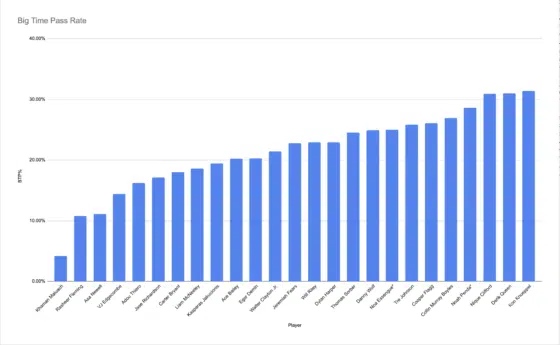

Three prospects I charted eclipsed a 30% big-time passing rate — Kon Knueppel, Nique Clifford and Derik Queen. I view all three of these players as underrated passing prospects and this metric can help explain that. Though these players don’t pass as much as some others, they consistently exhibit high-quality vision, anticipation, manipulation and skill on their passing chances.
We can combine passing volume and passing quality metrics to estimate the most impressive passers in the class, comparing passing chances and big-time passing:
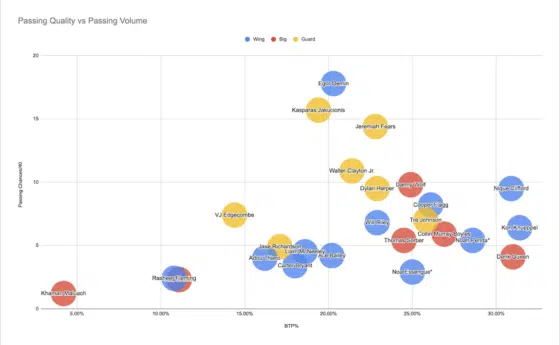

Our highest volume passers (Demin, Jakucionis and Fears) all rank closer to average by passing quality, but some of this comes with their heavy on-ball role. All three uncork plenty of high-level passes, but on-ball roles force plenty of basic assists, especially on strong offenses like BYU’s.
By raw big-time pass totals, the three highest volume passers rank second, third and fourth, only trailing Clifford (94 big-time passes). Still, the players towards the top right of the chart above generally line up with the best passers in the class on film.
Aside from passing quality, pressure rates and playmaking under pressure were the other main metrics this project aimed to create. Here are the leaders among prospects I charted in passing pressure rate, including how often they created potential assists from those possessions:
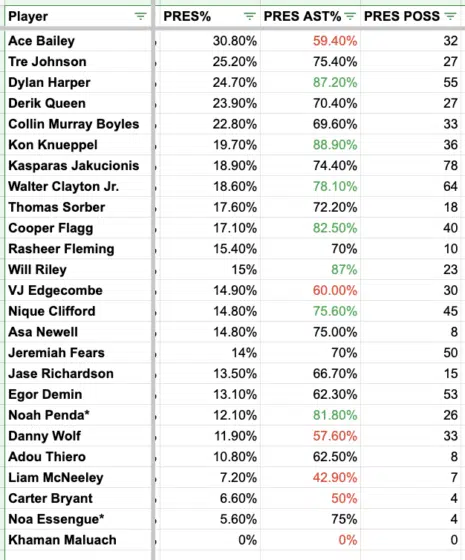

Dylan Harper is the main standout here, as he ranks third among the class in pressure rate (24.7%) and second in pressured potential assist rate (87.2%). Though this doesn’t account for Harper’s ability to burn pressure with his handle or shots, it reflects well on his future on-ball value. Jakucionis faced the most total pressure and mostly succeeded in cracking defenses with his playmaking.
Specifically, charting passing turnovers can help offer context for a high-turnover player like Jakucionis, where most of his turnovers stem from handling and strength limitations rather than mental processing ones. Jakucionis provides an example of a broader trend here.
Earlier, we noted the strong positive correlation between my charted passing volume and assist rate, which makes logical sense. However, the same doesn’t hold when we visualize charted passing turnovers against raw turnover rates:
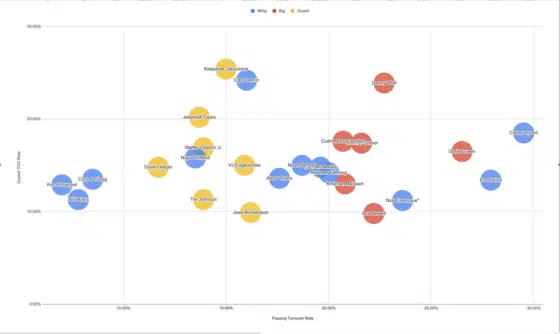

Rather than our strong positive correlation, this chart reveals a weaker correlation (r² = -0.57) between raw turnovers and passing turnovers. Not all turnovers result from a pass, so this relationship underscores the need for better analysis of individual player giveaways.
Some players towards the top right of the chart (Danny Wolf, Carter Bryant, Derik Queen) have both high turnover rates and high passing turnover rates, indicating possible problems with decision making, accuracy or skill. Some high turnover players like Jakucionis don’t cough the ball up while passing often, and some lower overall turnover players (Ace Bailey, Asa Newell) turn it over often relative to their passing volume.
Even beyond the passing versus non-passing turnover distinction, not all passing turnovers are equal. For each prospect, I logged when a turnover stemmed from a mental error or a technical one, as mentioned earlier, to better understand why a player turns the ball over and how to interpret their turnover numbers going forward (ordered by passing turnover rate, descending left to right):
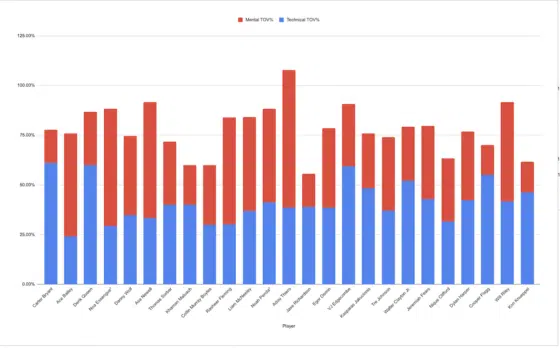

Players with more blue comprising their bar turned the ball over more often because of technical errors and players with more red comprising their bar turned the ball over more often due to mental errors. Not all turnovers are easily bucketed into one category. Some are the fault of both mental and technical issues and some passing turnovers aren’t the passer’s fault, resulting in some players notching above or below 100% on the chart above.
For prospects like Flagg and Queen, the majority of their passing turnovers resulted from accuracy and placement errors, which we could interpret more optimistically than prospects like Bailey and Newell, whose decision-making and processing more consistently faltered.
Let’s visualize how often prospects passed for easy shots at the rim (rim potential assist rate) versus how often they created potential assist chances from self-created paint touches (paint touch potential assist rate):
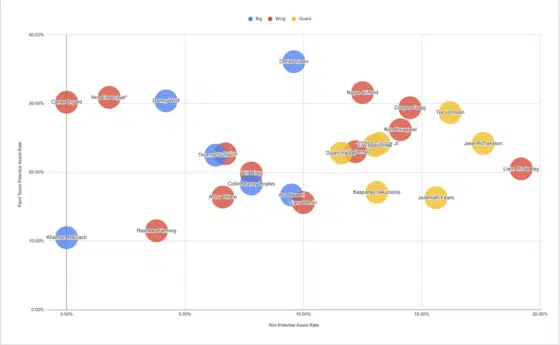

As a reminder, this metric doesn’t encompass paint touches without a pass, but there appears to be some anecdotal correlation between players who live near the hoop (Queen, Wolf, Clifford) and the paint touch metric.
We can infer that players towards the top (Queen) mostly kick out of the paint to shooters and players towards the top right (Flagg, Tre Johnson, Jase Richardson) lay down passes for rim attempts. Those top-right prospects both collapse defenses and find high-value passes, which could forecast them optimistically as shot creators at the next level.
Based on these metrics and the film, who are the best passers in the 2025 NBA Draft? Before we answer that question, let’s look at one more chart, visualizing the relationship between passing quality (big-time pass rate) and passing turnover rate:
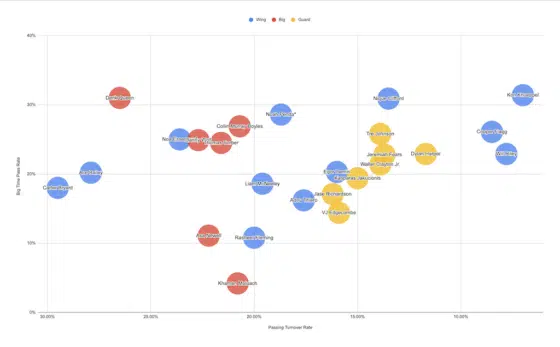

If I had to choose one chart from the piece to best represent the premier playmakers in the class, I’d pick the one above. Creating high-value passing chances without turning the ball over is a valuable commodity, reflected in most of the players I view as the best passing prospects in this draft.
Kon Knueppel
Knueppel’s best passes come when he feeds his rolling big man, often feeding the towering Khaman Maluach easy points. He processes defenses instantly on the fly, placing these interior passes accurately, often into tight windows while facing some pressure.
kon knueppel’s big time pass rate (31.4%) was the highest of any prospect i’ve tracked so far and that’s no accident. he’s a special processor on the move
incredible timing on these lob passes and laydowns, he showcases ridiculous vision and placement on these passes pic.twitter.com/o00dqkDiQz
— ben pfeifer (@bjpf_) June 13, 2025
It’s incredibly rare for players to process the floor as quickly as Knueppel while consistently throwing high-value, often tight-window passes without turnovers. While Knueppel doesn’t break defensive structures like the best passers in the league, his playmaking brilliance comes in the form of remarkably consistent play-to-play decision-making on high-value passes.
Returning to the chart just above this section, he leads the class in big-time passing rate (31.4%) and passing turnover rate (7%) with solid enough passing volume (12th among all prospects). That’s an incredibly impressive feat, especially considering how Knueppel scaled his playmaking up in games without Cooper Flagg.
There’s an important distinction between passing and playmaking and Knueppel balances those as well as any prospect in the class. Some players can’t weaponize their brilliant processing, passing skill or vision because they lack the handle or scoring gravity to force defensive movement.
His gravity pulls two defenders his way after flaring off the Maluach screen, which forces rotations and opens the skip pass. Knueppel processes this instantly, releasing the pass within a second of catching the basketball. Plays like these let Knueppel wield his playmaking power without dominating the ball:
Kon offball pass pic.twitter.com/qT8Cc5U5HY
— bjpfclips (@bjpfclips) June 25, 2025
Knueppel’s magnetic shooting gravity and solid burst make him a dangerous on and off-ball playmaker who will create easy shots for his teammates. He’s a phenomenal pick-and-roll player, but his passing out of on-ball chances, closeout drives and off-ball movement help him create more efficient shots than more traditionally elite passers.
Derik Queen
Queen’s traditional passing statistics (0.8 assist-to-turnover rate, 11.6% assist rate) don’t paint him as a particularly strong passer. Our passing metrics present more of a mixed bag — he ranks second in big-time passing rate, fourth in pressure rate, first in weak-hand pass rate and first in rim potential assist rate.
However, he ranks 23rd in passing turnover rate and 19th in potential assists per 40 minutes. If Queen’s overall passing quality grades so highly, why doesn’t he create more shots for his teammates?
Though Queen’s high passing turnover rate could cause some concern, a staggering 60% of those turnovers, ranking second, result from technical mistakes. He ranked sixth in the class in mental turnover rate (26.7%), as many of his passing giveaways look like this, resulting from accuracy issues and avoidable, unforced errors:
Queen tovs pic.twitter.com/RSgQkXjLsy
— bjpfclips (@bjpfclips) June 25, 2025
Queen’s low passing volume isn’t as easy to decipher. Some of it may result from Queen’s wiring leaning towards scoring, especially on a Maryland offense that relied heavily on his creation. Maryland’s offense improved a staggering 16.5 points per 100 possessions with Queen on the floor, evidencing his huge importance to their success.
Though Queen currently tilts toward a score-first playstyle, I generally trust players as talented as him to adapt and grow. There simply aren’t many players, especially in the frontcourt, with Queen’s vision, live-dribble ambidexterity and processing speed.
While he can capitalize on his scoring gravity to create for teammates, his lightning-fast processor adds value off-ball. Queen tossed quite a few assists like the first clip here, where it’s almost a touch pass with how fast the ball moves:
derik queen is constantly throwing high level, high degree of difficulty passes, flashing NBA level processing speed, vision and skill on these reads
near 27% big time pass rate (per my hand tracking), i’m a big believer in his passing ceiling pic.twitter.com/hyBCGgTao2
— ben pfeifer (@bjpf_) January 24, 2025
Those traits allow Queen to excel as an on-ball and off-ball passer. Though his numbers might not suggest it, I view Queen as one of the very best passing prospects in the class, regardless of position, for his phenomenal blend of gravity, vision and creativity.
Egor Demin
Demin would likely win a consensus poll for best passer in the 2025 class. It isn’t hard to understand why — at 6-foot-8, he comfortably leads the 25 prospects charted in passing volume by traditional assist rate and my passing chances measure. He spent the bulk of his time on the ball as a primary pick-and-roll initiator for a strong BYU offense this season.
He sports a sixth sense for space, timing and movement, passing like he’s constantly reading a miniap displaying every player and their position on the court. That court mapping leads to some incredible anticipatory passes, where Demin throws his target open like an elite quarterback.
Watch Demin uncork this pass before his target even enters the paint, leading him right to the block for a wide-open layup despite heavy traffic in front of the pass:
Demin anticipation pic.twitter.com/WatHQgcV0Q
— bjpfclips (@bjpfclips) June 25, 2025
His height lets Demin attempt passes that other passers simply couldn’t imagine. While he’s doubled out to half-court, Demin launches a pass half the length of the court, leading his big man away from the rotating defender by lofting it away from the middle of the floor:
Demin wild pass vs double pic.twitter.com/CRXdndfv9h
— bjpfclips (@bjpfclips) June 25, 2025
Demin’s height, vision, live-dribble trigger and sheer ambition render him the clear best skip passer in the class. He ranked 23rd in rim potential assist rate, illuminating his preference for exterior passing. Some of these skip passes come with ludicrous timing, velocity and ball placement, helping Demin create tons of open threes for great shooters:
Demin skip pic.twitter.com/0HivbdrZsY
— bjpfclips (@bjpfclips) June 25, 2025
Even with some obviously special passing traits, Demin offers an opposite example to Knueppel in the passing versus playmaking discussion. Despite possessing the mental acumen and technical skill to make every pass in the book, Demin may struggle to execute those passes.
He isn’t an accurate 3-point shooter, struggles to create separation on drives and turns the ball over at the slightest hint of contact. Though Demin’s passing talent will always let him punish tilted defenses, his inability to force defensive movement and rotations could hinder how much value his passing can add in an on-ball role.
Notice what happens when defenders play the pass against Demin, ignoring his scoring threat. Demin drives into open space here, but the help defenders read his intention to pass and back off to close the gap and force a turnover:
Demin tov pic.twitter.com/thfyeAoInu
— bjpfclips (@bjpfclips) June 25, 2025
A weak handle, average burst and poor strength and balance limit Demin’s ability to unleash his passing brilliance. Improvement in any of those areas will help Demin extract more value from his playmaking at the NBA level. If he ever provides any semblance of a scoring threat on the ball, Demin has the tools to develop into one of the NBA’s better playmakers.
The strength of the 2025 draft’s overall passing makes it challenging to determine the best playmaking prospect of the bunch. I’d group the three above as the most intriguing passing prospects, but it’s reasonable to argue for Flagg, Clifford or Jakucionis as the best passer in the draft as well.
Beneath those prospects, the class features a handful of strong but limited passers in one or more way, notably Collin Murray-Boyles, Dylan Harper, Noah Penda and Jeremiah Fears. I’d love to write more in-depth passing profiles in the future, but my greatest hope for this project is expanding it to cover past and future draft classes.
For the moment, these metrics across a single draft class reveal some insights, but we can’t know the true predictive power of any of these metrics without a historic sample. At some point, I want to chart passes for historic prospects who did or did not become great NBA passers and if any of the metrics indicated that.
Assuming my current state of life doesn’t change too much, I plan on continuing this project over to the 2026 class. For the next cycle, I have a few changes in mind. As I previously alluded to, I’ll stop specifically charting live-dribble passes and focus more on on-the-move passing to capture a broader scope of plays and better estimate live-dribble processing.
Going forward, I’d like to develop a method for charting accuracy and decision speed. Measuring accuracy could be challenging without precise tracking data. Still, eyeballing placement, logging plays that almost resulted in turnovers but didn’t or charting tight versus open window passes could offer reasonable estimates. As always, I’m open to any suggestions here.
This project is inherently subjective and shouldn’t be viewed as a substitute for more traditional statistical measures; rather, another tool to enhance our knowledge of prospects. A different scout charting for the same thing might come to different conclusions than I would.
It’s important to note that plenty of these prospects have extremely limited samples, which lowers the confidence in the accuracy of the metrics. Gleaning much of anything from players like Newell, Maluach and Fleming with fewer than 100 total passing chances won’t uncover much definitive information.
Closely watching and writing notes on nearly 5,000 passes across 25 prospects will lead to inevitable human error. I undoubtedly miscounted, botched a calculation or evaluated a clip incorrectly at least a few times.
This project was a labor of love. Countless hours watching film, refining my process and creating this data isn’t something I would recommend anybody else do, but it brought me immense joy throughout the cycle. I love basketball deeply and I love obsessing over fine details. Intentional tracking work like this helps keep me grounded and present, which never hurts.
If you read this piece and made it through these 4,000 or so words, please know how deeply I appreciate it. I hope this project that brought me so much joy and insight can do the same for you and, again, this will ideally act as the beginning of my passing charting to keep expanding our understanding of projecting playmaking for NBA draft prospects.


